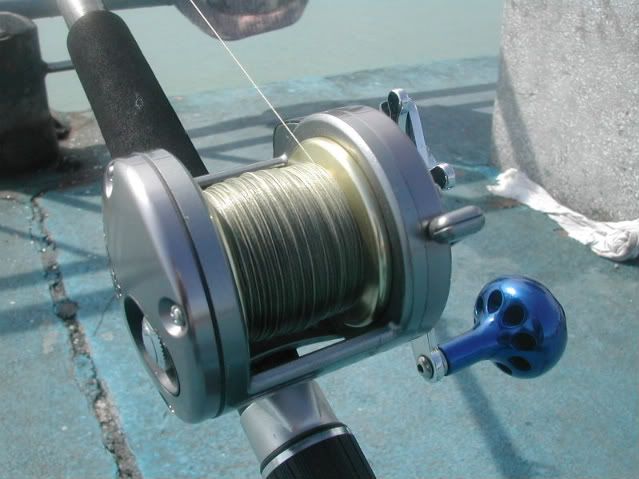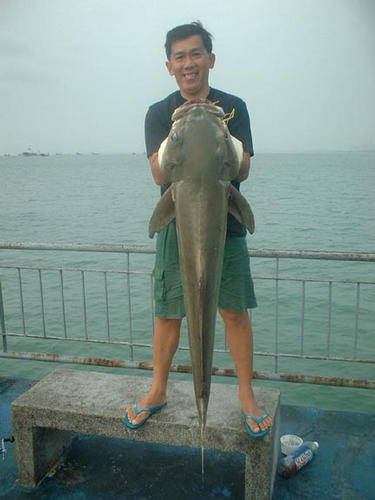Contact Me
My name is Alo. I am known as Shoreangler in the fishing forum here. At bedok jetty, many people call me Alo. I am now a surf fishing advisor to our local fishing magazine HOOKED
My E-mail
My Address
My main website
Me the shoreangler:
Born in the year of 1957, I am among some of the older anglers here. Many anglers of this age have either retired or turned to light fishing during their free time. In fact, anglers at my age are mostly handline anglers; due to the practice they had during their prime age. Not much of these anglers attempt to change like what I had done to be a big game surfcasting angler.
With home being just about one kilometer away from the sea, a place called “mata ikan”; fish eye in malay, it is located on the eastern side of Singapore. It is a small village where most villagers are fishing men with small sampans who goes out to sea, catching fishes with nets. As a young boy during the 1960s, I used to go to the beach where the fishermen would unload their catches in the morning. I even helped to untie crabs and fishes caught from those nets.
In 1968, when I was just eleven years old, I started to do my own “ rod” for fishing. With the help of some kampong guys, we would make our own fishing rod. This custom-made rod consisted of a thin bamboo pole about 6 to 7 ft in length tied with a light mono line about 6 feet long. The rig was a small sinker purchase at the small kampong provision shop tied with two small hooks. Our target was the Whiting Fish or as it is locally called, the “Swa Chiam”.
With the self made rod in hand and a floating bamboo-made keeper net tied with a rope to the waist, we would make our way to the beach. Usually during the dawn or dusk period, we would follow the elders and hunt for bait when we reach the beach. Sea worms were what we looking for.
At that time, Singapore was still a natural island without any reclaimed land. The beach was full of big fat worms; getting them was easy. All we needed to do was to look out for big patches of seaweed on the beach or any dead fishes that had floated to shore and lay dried up on the sand. Just by removing the seaweed or dead fishes; one would find lots of tiny holes below them. With a quick scoop into the soft sand by your hand, you will get a big handful of huge fat sea worm.
We will fill empty condensed milk cans with the huge worms and add in some dry soft sand to keep it alive for days. We tie a small string on the can and hang it around our neck for easy baiting. Fishing was usually done by following the receding tide or incoming tide. On a receding tide, we will follow the tide and walk out into the sea. During that time, the sea bed was hard on the natural beach. One could walk out to the sea up to few hundred metres away during a big low tide. Most of the fishing was done with the seawater at knee level. Any catches would be deposited into the floating bamboo net that would keep it alive. For an incoming tide, we would retreat back up the shore as the tide is coming in.
During the early 1970s, Singapore started to reclaim land. It began at the eastern shore and started at the Tanjong Rhu area. Within few years, Bedok jetty was built. By this time, the beach infront of my house was under reclaimation. I had to change my spot so I cycled down to the jetty to fish.
Although it was built mainly for the navy to use, the public could still enter whenever the navy ship was away. When the ship arrived, the authorities would condon off the jetty's outer end, leaving the first part of the jetty open for anglers to fish.
From mid 1970s to 1980s, I stopped fishing due to my national service and work commitments. It was after many years that I started picking up my hobby again; this time with a a new way of fishing by surfcasting with a long rod and spinning reel. Prawn meat was used my main bait and I caught palm sized fishes like guramah, fingermark snapper and grouper.
After 1990 onwards, I was attracted by the new multiplyer reel on the market. I bought my first Penn 155L beachmaster multiplyer at the then- K Mart supermarket at Marina Square. I used it to surfcast big bait at Bedok jetty and most of the breakwater stones along the east coast beach. Changi beach is another hot spot I often frequented. Many big stingrays , marine catfishes and cobias beside those smaller fishes were caught. However when I told others about my catches, many didn't believed “Singapore shoreline where got such big fish?” they asked.
It was only in 1995 that I decided to buy a camera to take photo of my catches. I wanted to prove what I had said and also for to keep the photographs for remembrance. At this time, reclaimation land work on the sea outside the Changi airport was going on. The project was done by a Korean company call Hyundai construction and natually the place was named “Hyundai” by the angler. With this reclaimation work, it provided a lot of places to fish on deep water from the shore. My buddy and I spent about two years visiting these places every weekend. Many big fishes were caught from these areas until it was banned when the defence ministry started building a new airfield there.
Soon, we moved to the next spot - the “Obayashi”. This place was named after it was reclaimed by the Japanese Obayashi construction company. At the beginning, vehicles could not move in as the road was blocked. The only way to reach there was to cycle in. Thus, every weekend morning I will meet some anglers at the entrance of Bedok jetty and we will cycle all the way there. Unfortunately, as it was a newly reclaimed land, many parts of it were still with soft sand. We had to push our bicycles for about 200 metres to reach the fishing place. Here, many good fishes were caught. Big fingermark snapper, grouper, stingray, queenfish, cobia, red snapper, marinecatfish and many more. Even a rare bird ray was caught and released. All in all, we spent about two years here until the place was designated to be the new Changi naval base.
After the millenium, I was back at Bedok jetty. At the same time, Labrador jetty was also opened. Always looking out for new spots, I was amongst the first few anglers to fish there and also started catching squids. During that time, there was no carpark below the hill. Everyone had to park their car on the hill top and walk down the wooden stairs. Going down was alright but when it was time to climb back up with all the squid lamp and tackles, not many anglers were willing to do that. Time to time when the jetty was too crowded, I would go and find new places to fish at. I had planted my foot print on Tuas reclaimed land, Sentosa, Marina South, Changi board walk, etc etc. But after many years of wondering around, I decide to stay mostly at Bedok jetty as it is near to my house. Clean, deep water, easy to look for fresh bait, it is one of the most popular spot for shore fishing in Singapore.

